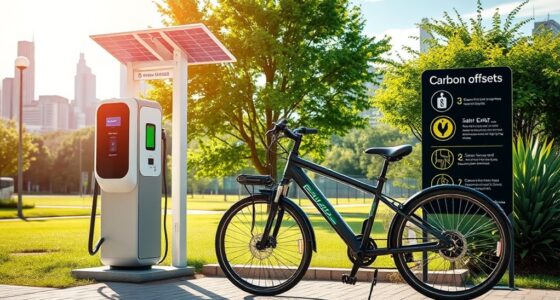To practice zero-waste bike maintenance, focus on eco-friendly cleaning with biodegradable solutions like vinegar and baking soda, and minimize water use with waterless sprays and microfiber cloths. Repair and recondition parts instead of discarding them, and get creative by upcycling old components into art or functional items. Support sustainable gear choices and participate in community repair events. If you want to explore more ways to reduce your environmental impact, there’s plenty of advice to help you get started.
Key Takeaways
- Use biodegradable cleaning products like vinegar and baking soda, and minimal-water cleaning methods to reduce water and chemical waste.
- Repair and reuse existing bike parts instead of discarding, supporting a circular economy.
- Upcycle old components into decorative or functional items, minimizing waste and extending their lifecycle.
- Choose sustainable gear made from recycled or eco-friendly materials and support responsible, local suppliers.
- Organize community repair workshops and cleanup events to promote eco-conscious maintenance and shared resourcefulness.
Embracing Eco-Friendly Cleaning and Lubrication Strategies
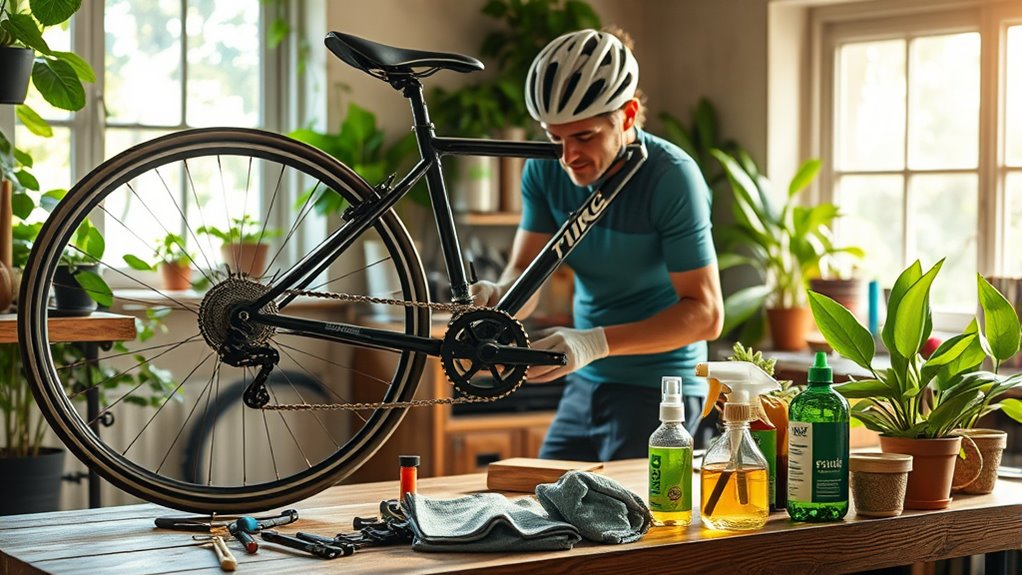
To minimize your environmental impact, it’s essential to choose eco-friendly cleaning and lubrication methods for your bike. Start with biodegradable cleaning products like vinegar and baking soda, which effectively clean your bike without polluting waterways. Use plant-based, biodegradable lubricants to keep your bike running smoothly while reducing chemical runoff. Adopting waterless or minimal-water cleaning methods, such as wiping with eco-friendly cloths or applying waterless sprays, helps conserve water. Regularly inspecting and cleaning components prolongs their lifespan, decreasing the need for replacements and waste. Avoid harsh chemical degreasers by opting for natural alternatives, ensuring your bike’s performance stays ideal without harming the environment. Incorporating biodegradable products into your routine further supports sustainability and reduces pollution. Understanding the benefits of regional resources can also help you find local eco-friendly maintenance options. Awareness of the weight of your bike and components can help you handle it more efficiently when performing maintenance, reducing the risk of damage. These sustainable maintenance practices support a cleaner planet and a healthier ride.
Repairing and Reusing Bicycle Parts to Minimize Waste
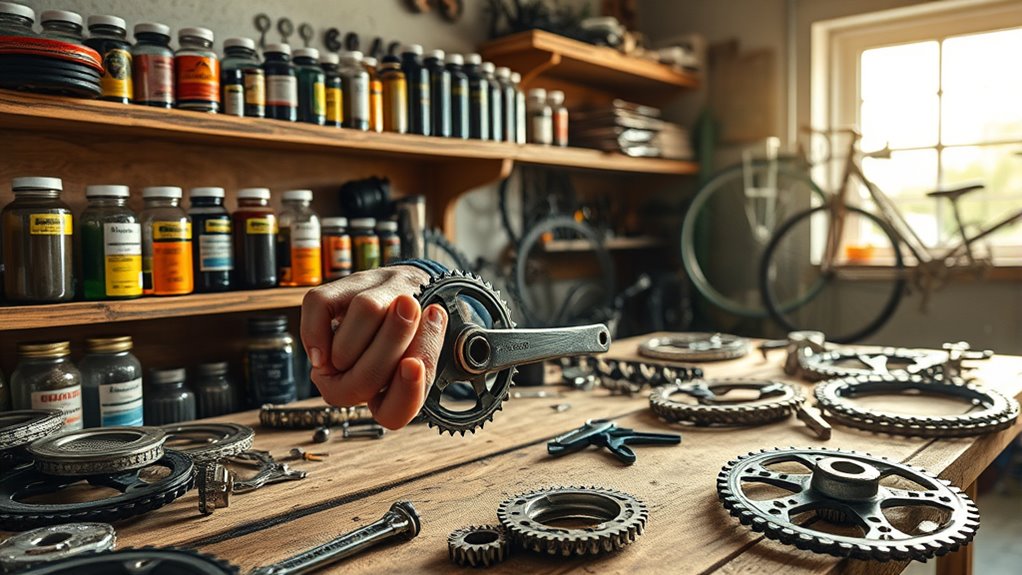
Repairing and reusing bicycle parts is a practical way to reduce waste and extend the life of your bike. Instead of discarding damaged components like tires, chains, or brake pads, focus on repairing them to keep them functional. Reusing or refurbishing old parts can also give them new purpose—think turning worn-out tires into planters or repurposing frames into furniture or art. Supporting recycling programs offered by bike shops helps ensure waste is properly managed and materials are reused or recycled. You can even upcycle parts into decorative or functional items, minimizing environmental impact. Additionally, donating unused but functional components to community programs or repair initiatives promotes a circular economy, preventing waste and encouraging sustainable bike maintenance. Moreover, understanding credit card terms can help you make smarter purchases and avoid unnecessary fees when buying biking accessories or services. Staying informed about global economic outlook can also help you make better decisions when investing in high-quality, durable bike parts. Keeping track of market trends and indicators can assist in timing your purchases and repairs more effectively. Furthermore, exploring eco-friendly materials for bike parts can contribute to a more sustainable cycling experience. Additionally, utilizing low light office plants can improve indoor air quality while maintaining an eco-friendly workspace.
Implementing Water-Conserving Cleaning Techniques

Implementing water-conserving cleaning techniques is an effective way to maintain your bike while reducing environmental impact. You can use a bucket of water with biodegradable cleaning products instead of a hose, promoting water conservation. Waterless bike cleaning sprays and microfiber cloths clean surfaces efficiently without using any water. When rinsing is necessary, spray only the affected areas, avoiding bearings, hubs, or bottom brackets to prevent water ingress. Eco-friendly degreasers also require minimal rinsing, helping you practice sustainable bike maintenance. Proper color accuracy in cleaning tools and techniques ensures an effective and environmentally friendly process. Incorporating proper technique can further enhance the effectiveness of your water-saving methods. Using timing and frequency to clean your bike appropriately can prevent excessive water use and prolong the lifespan of your components. Here’s a visual to guide your water-saving efforts:
| Technique | Benefits | Equipment Needed |
|---|---|---|
| Waterless cleaning sprays | Saves water, eco-friendly | Microfiber cloths |
| Rinsing only affected areas | Prevents water ingress | Spray bottle |
| Biodegradable products | Reduces chemical impact | Eco-friendly degreasers |
Recycling and Upcycling Old Components Creatively
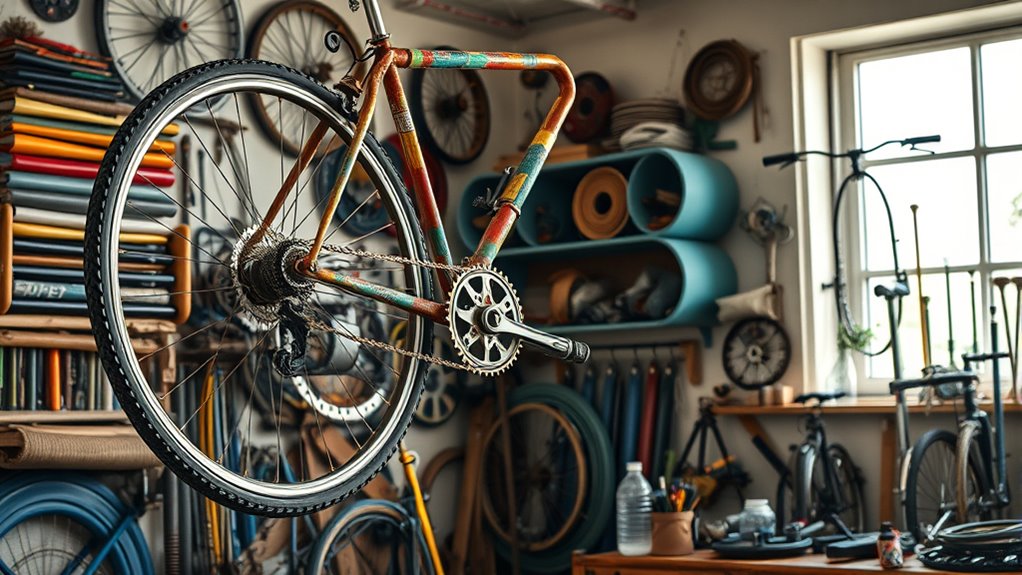
Recycling and upcycling old bike components offers a creative way to reduce waste and give new life to materials that might otherwise be discarded. You can transform worn-out tires into planters, wallets, or door mats through simple cutting and sewing techniques. Disused chains and gears make stylish jewelry or decorative art pieces, while old frames can become eco-friendly furniture like chairs or tables with welding and eco-paints. Used inner tubes can be converted into waterproof bags, wallets, or braided bracelets, extending their usefulness. Vintage parts like pedals or handlebars are perfect for DIY home decor projects. Additionally, sustainable practices in bike maintenance promote environmental responsibility and resourcefulness. Practicing mindfulness while working on projects can enhance your creative process and deepen your connection to the environment. Incorporating certified quality ingredients in your cleaning and repair products can further ensure your bike stays in top condition while supporting eco-friendly options. Exploring recycling techniques further enhances your ability to repurpose materials effectively. Being aware of environmental impacts guides you toward making more sustainable choices in your projects. By engaging in recycling and upcycling, you not only minimize waste but also showcase your craftsmanship and resourcefulness, making your bike maintenance truly zero-waste.
Selecting Sustainable Gear and Supplies for Maintenance

Selecting sustainable equipment and supplies for bike upkeep is vital for minimizing environmental impact. You can start by choosing eco-friendly supplies, like biodegradable or plant-based lubricants and cleaning products, to reduce chemical runoff. Look for gear made from recycled or sustainably sourced materials, such as recycled aluminum frames or hemp bike bags, which help lower resource consumption. Supporting local and eco-conscious suppliers ensures packaging-free options and responsible shipping practices. Opt for second-hand or refurbished components and accessories to extend product life and avoid unnecessary waste. Research brands that prioritize sustainable manufacturing and use eco-friendly materials, making your maintenance practices more environmentally responsible. By choosing these sustainable gear options, you’ll contribute to reducing waste and promoting a greener cycling community.
Building Community Initiatives for Eco-Conscious Cycling
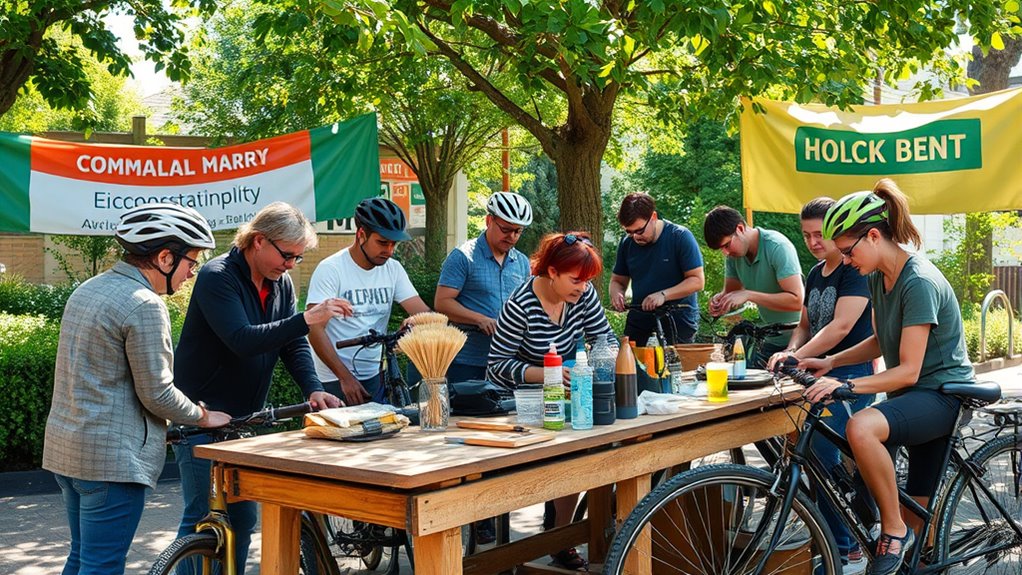
Getting involved in community rides and maintenance days can boost awareness and encourage eco-friendly cycling habits. Partnering with local organizations to set up repair stations and cleanup events makes sustainable biking more accessible. Using social media to share stories and organize events helps create a strong, supportive network of eco-conscious riders. Incorporating juice cleansing practices into community health initiatives can further promote overall wellness among cyclists and encourage sustainable lifestyles. Additionally, promoting AI security in community programs ensures that data collected during these events remains protected and confidential. Implementing Volkswagen Tuning techniques can inspire innovative ways to optimize bike performance and sustainability. Understanding skin benefits of various maintenance products can help in promoting healthier cycling environments and rider well-being. Exploring eco-friendly materials for bike components can also enhance the sustainability of cycling practices while reducing environmental impact.
Community Engagement Strategies
Building a strong community around eco-conscious cycling starts with active engagement and collaborative efforts. You can foster community engagement by organizing repair days and workshops that promote sustainable practices and teach eco-friendly bike repair techniques. Partner with local cycling clubs, schools, and environmental groups to create initiatives like repair stations and clean-up events that inspire shared responsibility. Use social media to promote these activities, share maintenance tips, and connect environmentally conscious cyclists. You can also establish bike donation and upcycling programs that extend the lifespan of parts and encourage creative reuse. Supporting local businesses that prioritize sustainable practices further reinforces your community’s commitment to eco-friendly cycling. These strategies create a vibrant, engaged network dedicated to reducing waste and promoting zero-waste bike maintenance.
Partnerships and Local Events
Forming strong partnerships with local cycling clubs, community centers, and environmental organizations is essential for creating impactful community initiatives that promote eco-conscious cycling. You can organize zero-waste maintenance workshops to teach sustainable practices and collaborate with environmental groups in New Zealand to set up repair stations stocked with biodegradable products and eco-friendly tools. Hosting regular community events like bike repair days and cleanup rides boosts engagement and spreads awareness of sustainable cycling. Supporting local businesses through joint initiatives and sponsorships helps source eco-friendly parts. Use social media to promote these efforts, share success stories, and coordinate zero-waste events. These partnerships and community events build a strong, environmentally responsible cycling culture.
| Partnership Type | Community Event Example |
|---|---|
| Cycling clubs, community centers | Repair workshops, cleanup rides |
| Environmental organizations | Repair stations, eco-fairs |
| Local businesses | Sponsorships, product sourcing |
| Social media platforms | Promotion, success sharing |
Incorporating Zero-Waste Mindset Into Regular Bike Care

To incorporate a zero-waste mindset into your bike care, start by choosing eco-friendly products like vinegar and baking soda for cleaning. You can also minimize water use and focus on repairing and reusing bike parts instead of replacing them. These simple steps help reduce waste and keep your bike maintenance more sustainable.
Use Eco-Friendly Products
Incorporating eco-friendly products into your bike maintenance routine is a simple yet impactful way to embrace a zero-waste mindset. By choosing biodegradable cleaning agents like vinegar and baking soda, you avoid toxic residues and reduce environmental harm. Opt for plant-based, eco-friendly lubricants to extend your bike’s lifespan and minimize runoff. Always select products with recyclable packaging to cut waste and support sustainability. Supporting brands that prioritize recycled or sustainably sourced materials further aligns your maintenance practices with zero-waste principles.
Some key steps include:
- Using biodegradable cleaning agents
- Choosing eco-friendly, recyclable packaging
- Supporting brands committed to sustainability
- Replacing chemical cleaners with minimal-water solutions
These choices help you maintain your bike responsibly while reducing your ecological footprint.
Minimize Water Usage
Have you considered how minimizing water use can enhance your bike maintenance routine? Water conservation is key to a zero-waste approach. Instead of hosing down your bike, use a bucket with biodegradable cleaning solutions to wash it, reducing water consumption. Avoid high-pressure rinses, which can push dirt into bearings and sensitive parts, leading to more cleaning and water use. Instead, opt for dry cleaning methods like wiping with biodegradable cloths or brushes to remove surface dirt efficiently without water. When rinsing is necessary, limit it to essential areas and reuse wastewater when possible, ensuring it doesn’t contaminate waterways. Regularly inspecting and maintaining your bike’s components reduces the need for frequent deep cleaning, further conserving water and supporting sustainable, eco-friendly bike care.
Repair and Reuse
By repairing damaged bike parts instead of replacing them, you can extend their lifespan and considerably reduce waste. Simple fixes like patching tires or fixing chains keep your bike in top shape while supporting sustainability. Reusing or repurposing old components is also impactful; for example, turn worn-out tires into planters or transform frames into furniture. Supporting local recycling and refurbishing programs helps minimize landfill waste and promotes a circular economy. Learning basic maintenance skills allows you to fix issues yourself, reducing reliance on disposable replacements. To deepen your zero-waste approach, consider:
- Repair instead of discard whenever possible
- Reuse old parts creatively
- Support community recycling initiatives
- Share or donate unused gear
This mindset keeps your bike sustainable and reduces environmental impact.
Frequently Asked Questions
What Regular Maintenance Should Be Done on a Bicycle?
You should perform regular maintenance on your bike to keep it in top shape. Check tire pressure monthly to prevent flats, inspect brake pads and cables for responsiveness, and clean and lubricate the chain every 100-200 miles. Also, examine wheel trueness and spoke tension biannually, and tighten bolts on the saddle, handlebars, and crankset quarterly. These steps guarantee safety and prolong your bike’s lifespan.
How Do I Maintain My Hybrid Bike?
So, you want to maintain your hybrid bike? Well, start by checking your tire pressure regularly, keeping it between 40-65 psi—because flat tires are so last year. Clean your chain with water and biodegradable cloth, then lube with eco-friendly products. Inspect brake pads monthly, adjust spokes for true wheels, and perform a thorough biannual check. Eco-conscious maintenance keeps your ride smooth and Mother Earth happy—what’s not to love?
How to Maintain a Bike Properly?
To maintain your bike properly, you should regularly check tire pressure between 40-65 psi to guarantee safety. Clean and lubricate the chain with eco-friendly products, and inspect brake pads and cables for responsiveness. Spin the wheels to check for true alignment, adjusting spokes if needed. Use environmentally friendly cleaning solutions like vinegar and baking soda, and avoid water at bearing areas to protect the environment.
How Often Should a Bike Be Serviced?
You might think bike servicing is complicated or unnecessary, but it’s essential for safety and performance. You should perform basic maintenance monthly, like checking tire pressure and brakes. A thorough service every six months or after 1,000 to 2,000 kilometers keeps your bike in top shape. Regular checks help prevent breakdowns, extend your bike’s life, and guarantee a smoother, safer ride every time you hit the road.
Conclusion
By adopting these zero-waste bike maintenance practices, you’re not just caring for your bike—you’re nurturing the planet. Every eco-friendly cleaning, repair, and reuse choice adds up, turning your routine into a ripple of positive change. Think of your efforts as seeds planted for a greener future, where sustainability rides alongside innovation. Stay committed, and watch how small, mindful actions transform your cycling experience into a powerful act of environmental stewardship.



